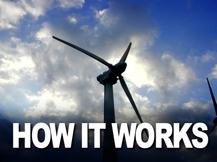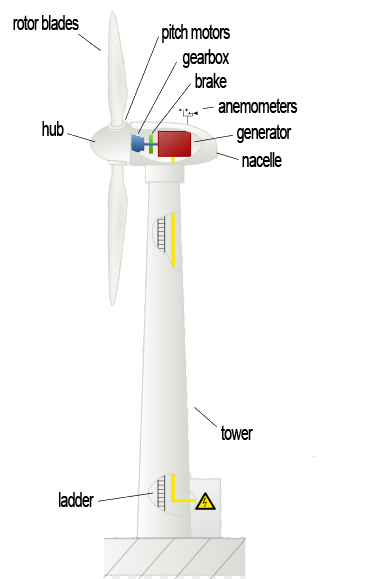How Wind Turbines Work
 Wind-generated electricity is one of the first images that comes to mind when someone says “renewable energy.” New wind farms—both massive and not so much—are under construction all over the world. But do you know how wind turbines work? It’s actually very cool.
Wind-generated electricity is one of the first images that comes to mind when someone says “renewable energy.” New wind farms—both massive and not so much—are under construction all over the world. But do you know how wind turbines work? It’s actually very cool.The image of a wind turbine is pretty familiar—it’s basically a massive three-bladed pinwheel on top of a huge stalk (in most cases). I’ve seen dozens of clusters while driving south through Illinois, and I’m sure most people have similar experiences. The blades turn (slowly) as the wind blows, generating electricity.
The Visible Bits
The pole supporting the moving parts of the wind turbine is called the “tower” (surprise, surprise). Directly on top of the tower is the nacelle, which is the housing for all the parts of the wind turbine that aren’t the giant blades.
Outside the nacelle is the most recognizable part of a wind turbine, the three blades attached to the hub in the middle. In slightly more technical terms, this assembly is called a rotor. Pitch motors in the hub allow the angle of the blades to be changed so that they can meet the wind.
Also outside the nacelle are the anemometers (wind vanes), which tell the turbine control system how fast the wind is and in what direction it’s blowing (no use in being able to adjust the blades if something isn’t telling them how to be adjusted).
The Inside Parts
Inside the tower are ladders for (relatively) easy access, and cables to export the electricity. Since the height of a wind turbine can range anywhere from 315’ to 540’, that’s not a ladder I’d want to climb (although better the ladder than attempting to scale the outside of the tower)
.
Inside the nacelle, the main shaft of the hub connects to a gearbox and a brake. Since rotor speeds are usually around 10-20rpm, which is utterly useless for generating any kind of power, the gearbox is responsible for converting that speed to something like 1,500rpm—much, much better for generating electricity.
The final component inside the nacelle is the generator, which is connected to the gearbox and the brake. It takes the 1,500rpm rotational energy and converts it into electrical power. The power is then sent out of the turbine through the cables running down the length of the tower.

A wind turbine can start producing power at wind speeds of 7-11 mph, but it reaches its full output at wind speeds of around 29mph. If it’s been appropriately placed, the turbine will generate over 40% of its maximum capacity over the course of each year it’s operational.
You can return to the main Market News page, or press the Back button on your browser.

